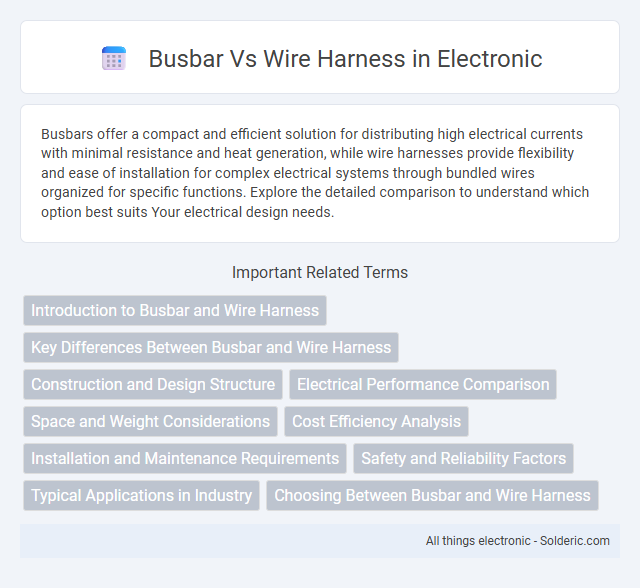Busbars offer a compact and efficient solution for distributing high electrical currents with minimal resistance and heat generation, while wire harnesses provide flexibility and ease of installation for complex electrical systems through bundled wires organized for specific functions. Explore the detailed comparison to understand which option best suits Your electrical design needs.
Comparison Table
| Feature | Busbar | Wire Harness |
|---|---|---|
| Definition | Metal strip or bar for conducting electricity within electrical systems | Assembly of electrical cables and wires bound together to transmit signals and power |
| Material | Copper, aluminum | Copper wires insulated with plastic or rubber |
| Current Capacity | High current carrying capacity, suitable for heavy electrical loads | Lower current capacity, suitable for signal and power transmission in circuits |
| Physical Form | Rigid flat or shaped bar | Flexible bundled wires |
| Installation | Mounted onto panels, switchgear, or busbar systems | Used inside machines, vehicles, and electronic devices for wiring organization |
| Application | Power distribution in electrical panels, transformers, switchboards | Complex wiring in automotive, aerospace, electronics, appliances |
| Advantages | High efficiency, reduced energy loss, compact power transmission | Easy installation, organized wiring, flexible routing |
| Limitations | Less flexible, bulky for small spaces | Lower current limit, potential for wire damage if mishandled |
Introduction to Busbar and Wire Harness
Busbars are rigid conductive strips or bars used to distribute electrical power efficiently within switchgear, panels, and busway enclosures. Wire harnesses consist of bundled electrical cables bound together for organized and flexible wiring in vehicles, machinery, and electronic devices. Understanding the differences between busbars and wire harnesses helps you select the appropriate electrical distribution method for your application's performance and space requirements.
Key Differences Between Busbar and Wire Harness
Busbars are rigid metallic strips designed for high current distribution within electrical panels, offering low impedance and efficient heat dissipation. Wire harnesses consist of multiple insulated wires bundled together to organize and protect wiring in complex electronic systems, providing flexibility and ease of installation. Your choice between a busbar and wire harness depends on the application's current capacity, spatial constraints, and need for durability.
Construction and Design Structure
Busbars feature a flat or bar-shaped conductive material, typically made of copper or aluminum, designed for high current distribution and efficient heat dissipation, while wire harnesses consist of multiple insulated wires bundled together with terminals and connectors for flexible electrical routing. The rigid, compact design of busbars reduces electrical resistance and inductance, enhancing performance in power distribution systems, whereas wire harnesses offer customizable configurations to accommodate complex wiring layouts in automotive and electronic applications. Busbars often integrate mounting holes and insulation coverings for secure installation, contrasting the variable shapes and protective sheathing found in wire harness assemblies.
Electrical Performance Comparison
Busbars offer superior electrical performance compared to wire harnesses due to their lower resistance and reduced voltage drop, resulting in enhanced efficiency and power distribution. Their solid, flat conductive material minimizes heat generation and energy loss, ensuring stable current flow even under high-load conditions. You benefit from improved reliability and consistent electrical output when choosing busbars over traditional wire harness systems.
Space and Weight Considerations
Busbars offer significant advantages in space and weight efficiency compared to wire harnesses, as they consolidate multiple electrical connections into a compact, flat conductor system that reduces bulk and clutter. Their rigid and streamlined design minimizes the volume required, enabling more compact electrical panel layouts and lighter assemblies critical in automotive and aerospace applications. Wire harnesses, while flexible and customizable, tend to occupy more space due to bundled cables and connectors, resulting in increased weight and potential routing challenges.
Cost Efficiency Analysis
Busbars generally offer superior cost efficiency compared to wire harnesses in high-current applications due to lower material costs and simplified installation processes. Wire harnesses can incur higher labor expenses and require more maintenance over time, increasing total ownership costs. When evaluating large-scale industrial or automotive systems, busbars reduce complexity and improve reliability, resulting in long-term cost savings despite potentially higher upfront investment.
Installation and Maintenance Requirements
Busbars simplify installation by providing a compact, modular design that reduces wiring complexity and time significantly compared to wire harnesses. Maintenance of busbars involves minimal inspection and quick fault isolation due to their straightforward, accessible layout, whereas wire harnesses often require extensive troubleshooting and rewiring efforts. Choosing busbars can enhance your system's reliability while cutting down ongoing maintenance costs.
Safety and Reliability Factors
Busbars offer enhanced safety and reliability due to their rigid, solid copper or aluminum construction, which reduces the risk of loose connections and electrical arcing. Wire harnesses, while flexible and adaptable, are more prone to wear, corrosion, and damage from vibration, increasing the likelihood of electrical failures. Proper insulation and secure mounting in busbars ensure consistent performance in high-current applications, making them a preferred choice for critical power distribution systems.
Typical Applications in Industry
Busbars are predominantly used in high-current applications such as power distribution panels, switchgear, and industrial machinery where efficient and compact electrical connections are critical. Wire harnesses find extensive use in automotive, aerospace, and consumer electronics industries due to their flexibility in routing complex wiring systems and ease of integration into confined spaces. Manufacturing automation and renewable energy sectors also rely on wire harnesses and busbars respectively, optimizing electrical connectivity for performance and reliability.
Choosing Between Busbar and Wire Harness
Choosing between busbars and wire harnesses depends on your specific electrical system requirements and space constraints. Busbars offer superior current-carrying capacity and efficient heat dissipation, making them ideal for high-power applications and compact installations. Wire harnesses provide flexible routing and ease of maintenance, suitable for complex wiring schemes and environments requiring frequent modifications.
Busbar vs wire harness Infographic

 solderic.com
solderic.com